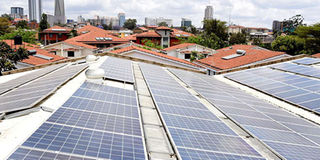Change your power bill from liability to asset

A building at Strathmore University, Nairobi, fitted with solar panels. You are better off with a borehole than tapped water and grid solar than electricity from a utility company. PHOTO | FILE | NATION MEDIA GROUP
What you need to know:
- Companies with high power costs are resorting to solar. The initial cost is heavy but, with time, the expenditure is spread over 20 years, the expected lifetime of a solar system.
- The customer life cycle concept has it that, in an average lifetime, you will consume a certain number of units of electricity and/or water. Capitalise that and you have a mountain of liability instead of a solid asset that can outlive you!
Utilities, especially electricity, is a liability and expense. You cannot get value from its consumption — maybe just the satisfaction derived from it.
You cannot, by any means, claim a share of the vendor by virtue of 100 years of consumption. To be fair, you cannot say the same of the food you consume but, then again, you do not have an alternative.
The paradigm shift is having utilities as an asset rather than an expense. You are better off with a borehole than tapped water and grid solar than electricity from a utility company.
The customer life cycle concept has it that, in an average lifetime, you will consume a certain number of units of electricity and/or water. Capitalise that and you have a mountain of liability instead of a solid asset that can outlive you!
LOSS
The cost of utilities such as electricity, sewer and water are an expense and liability. An individual will incur an expense for the amount of utilities used to heat and light her house.
Since the vendor provides the electricity before it bills the user (post-pay), the consumer incurs an expense and a liability every day, which increases by the day and is reduced by payments.
When a post-pay consumer pays the amount billed for the previous month’s usage, she will still have a liability for the utilities used since last month.
If you are using the pre-paid meter, then you must have had the annoying noise it makes when the units run low. Consider the much you will have paid in your lifetime!
For a manufacturer, the cost of the electricity used in the factory will be apportioned to the products as overhead. If all the products remain in inventory, the utility expense is fixed in the inventory’s cost.
SOLAR
When products are sold, the cost of utilities allocated to those products will automatically be expensed as part of the cost of goods sold.
Under accrual accounting, the cost is included in the products’ cost — whether or not the utilities have been paid for. Because of double-entry accounting, the amount owed for the utilities is reported on the balance sheet as a liability.
How will renewable energy change this, you may ask?
Companies with high power costs are resorting to solar. The initial cost is heavy but, with time, the expenditure is spread over 20 years, the expected lifetime of a solar system.
SMART
Accountants now charge a depreciation of the asset (solar system), which is tax-deductible, as opposed to having it as a cost component in production and a fixed cost of running the firm.
This dual effect has considerably reduced their cost of production and made the prices of their products more competitive.
For a marketer, this provides a competitive advantage and rhymes with Sustainable Development Goals 7 (Ensure access to affordable, reliable, sustainable and modern energy for all) and 13 (Take urgent action to combat climate change and its impacts).
If you are an exporter within the European market, this can make the difference between a deal and no deal.
Ms Hassan is the Kisumu branch manager of Solarnow, a renewable energy company. [email protected]





